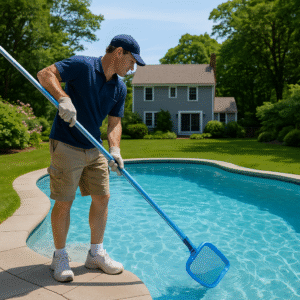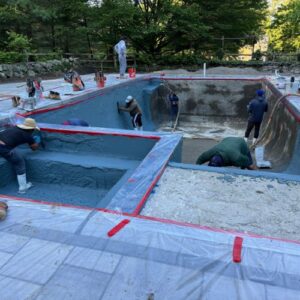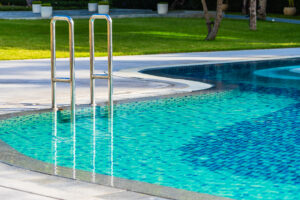Owning a gunite pool means you’ve invested in one of the most durable and customizable swimming pools available. But even the strongest pools need care over time — especially the interior surface. Resurfacing is a critical step in extending the life of your pool and keeping it safe, beautiful, and comfortable to swim in.
In this article, we’ll cover how to know when it’s time to resurface, your finish options, the benefits of resurfacing, and what to expect in terms of cost and scheduling.
Signs It’s Time to Resurface Your Gunite Pool
Most gunite pools will need resurfacing every 10 to 15 years, depending on maintenance, water chemistry, and the type of finish applied. But sometimes, you’ll notice warning signs sooner:
- Rough or pitted surface: If the plaster feels abrasive on your feet or swimsuits are snagging, the surface is wearing down.
- Stains and discoloration: Persistent stains that don’t respond to cleaning are often a sign the surface material has degraded.
- Exposed gunite: If the structural shell becomes visible, resurfacing is urgent to prevent damage.
- Frequent leaks: Cracks in the surface may allow water to escape, increasing your water bill and straining pool equipment.
- Chalky residue: When plaster breaks down, calcium deposits can cloud the water and coat pool walls.
Plaster vs. Pebble Finishes: Choosing the Right Look
When resurfacing, you’ll need to choose a new interior finish. Two of the most common options are:
Plaster
- The traditional choice for gunite pools.
- Smooth and classic white or colored look.
- More affordable, but typically lasts 7–10 years.
- Requires proper chemical balance to prevent staining or etching.
Pebble Finishes
- Blend of plaster and natural pebbles for a more durable surface.
- Available in a wide range of colors and textures.
- Can last 15–20 years with proper care.
- Offers a more natural, high-end appearance.
How Resurfacing Extends Pool Life
Resurfacing isn’t just cosmetic — it’s essential to the health of your gunite pool. Benefits include:
- Protecting the shell: The surface layer shields the structural gunite shell from water damage.
- Improving comfort: A fresh surface feels smooth and safe underfoot.
- Enhancing beauty: Restores your pool’s color and brightness, making it look brand new.
- Increasing longevity: Regular resurfacing prevents bigger structural problems down the road.
- Boosting property value: A well-maintained pool adds appeal and market value to your home.
Best Time to Schedule
- Spring and Fall: These are the ideal seasons for resurfacing. The weather is mild enough for the plaster to cure properly, and you’ll be ready before or after peak swim season.
Final Thoughts
Resurfacing your gunite pool is an essential part of long-term pool ownership. By recognizing the early signs of wear, choosing the right finish, and scheduling the work at the right time, you can keep your pool safe, functional, and beautiful for decades.
At Accelerated Pools, we specialize exclusively in gunite pools — from construction to long-term care. If your pool is showing signs that it’s time for a refresh, our team can guide you through the resurfacing process and help you choose the finish that fits your lifestyle and budget.
Contact us today to schedule a consultation and keep your pool looking and performing its best.



